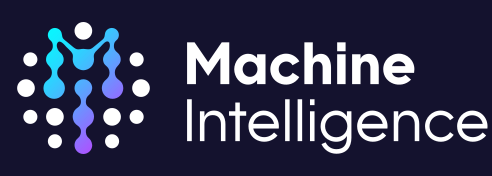| Cartesian Genetic Programming for Image Processing (CGP-IP) | |
| Simon Lawrence Harding, Juxi Leitner and Jürgen Schmidhuber | |
| Download | |
| Combining domain knowledge about both imaging processing and machine learning techniques can expand the abilities of Genetic Programming when used for image processing. We successfully demonstrate our new approach on several different problem domains. We show that the approach is fast, scalable and robust. In addition, by virtue of using off-the-shelf image processing libraries we can generate human readable programs that incorporate sophisticated domain knowledge. | 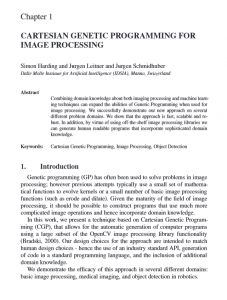 |
| An Integrated, Modular Framework for Computer Vision and Cognitive Robotics Research (icVision) | |
| Jurgen Leitner, Simon Harding, Mikhail Frank, Alexander Forster and Jurgen Schmidhuber | |
| Download | |
| We present an easy-to-use, modular framework for performing computer vision related tasks in support of cognitive robotics research on the iCub humanoid robot. The aim of this biologically inspired, bottom-up architecture is to facilitate research towards visual perception and cognition processes, especially their influence on robotic object manipulation and environment interaction. The icVision framework described provides capabilities for detection of objects in the 2D image plane and locate those objects in 3D space to facilitate the creation of a world model. | 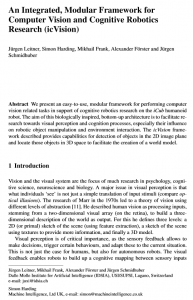 |
| Developments in Cartesian Genetic Programming: Self-modifying CGP | |
| Simon Lawrence Harding, Julian Francis Miller and Wolfgang Banzhaf | |
| Download | |
| Self-modifying Cartesian Genetic Programming (SMCGP) is a general purpose, graph-based, developmental form of Genetic Programming founded on Cartesian Genetic Programming. In addition to the usual computational functions, it includes functions that can modify the program encoded in the genotype. This means that programs can be iterated to produce an infinite sequence of programs (phenotypes) from a single evolved genotype. It also allows programs to acquire more inputs and produce more outputs during this iteration. We discuss how SMCGP can be used and the results obtained in several different problem domains, including digital circuits, generation of patterns and sequences, and mathematical problems. We find that SMCGP can efficiently solve all the problems studied. In addition, we prove mathematically that evolved programs can provide general solutions to a number of problems: n-input even-parity, n-input adder, and sequence approximation to π. | 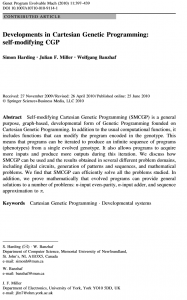 |
| MT-CGP: Mixed type cartesian genetic programming | |
| Simon Lawrence Harding, Vincent Graziano,Juxi Leitner and Juergen Schmidhuber | |
| Download | |
| The majority of genetic programming implementations build expressions that only use a single data type. This is in contrast to human engineered programs that typically make use of multiple data types, as this provides the ability to express solutions in a more natural fashion. In this paper, we present a version of Cartesian Genetic Programming that handles multiple data types. We demonstrate that this allows evolution to quickly find competitive, compact, and human readable solutions on multiple classification tasks. | 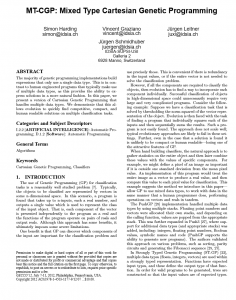 |
| Image analysis applied to Brillouin images of tissue-mimicking collagen gelatins | |
| Noemi Correa, Simon Harding, Michelle Bailey, Sophie Brasselet, and Francesca Palombo | |
| Download | |
| Brillouin spectroscopy is an emerging analytical tool in biomedical and biophysical sciences. It probes viscoelasticity through the propagation of thermally induced acoustic waves at gigahertz frequencies. Brillouin light scattering (BLS) measurements have traditionally been performed using multipass Fabry-Pérot interferometers, which have high contrast and resolution, however, as they are scanning spectrometers they often require long acquisition times in poorly scattering media. In the last decade, a new concept of Brillouin spectrometer has emerged, making use of highly angle-dispersive virtually imaged phase array (VIPA) etalons, which enable fast acquisition times for minimally turbid materials, when high contrast is not imperative. The ability to acquire Brillouin spectra rapidly, together with long term system stability, make this system a viable candidate for use in biomedical applications, especially to probe live cells and tissues. While various methods are being developed to improve system contrast and speed, little work has been published discussing the details of imaging data analysis and spectral processing. Here we present a method that we developed for the automated retrieval of Brillouin line shape parameters from imaging data sets acquired with a dual-stage VIPA Brillouin microscope. We applied this method for the first time to BLS measurements of collagen gelatin hydrogels at different hydration levels and cross-linker concentrations. This work demonstrates that it is possible to obtain the relevant information from Brillouin spectra using software for real-time high-accuracy analysis. | 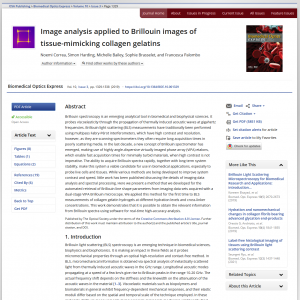 |
